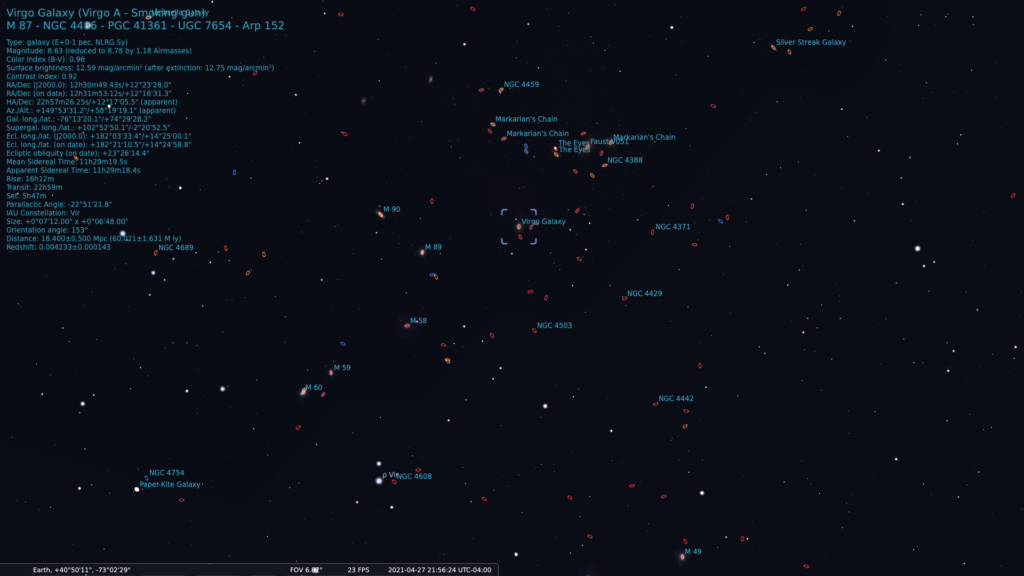A quick video showing the placement of the Virgo Cluster of galaxies with the massive elliptical galaxy Messier-87 at its center. Imaged with the Hubble Space Telescope, M-87 is shown here surrounded by thousands of globular star clusters. Our Milky Way galaxy, a member of the Local Cluster of Galaxies is, in turn, a member of the Virgo Super Cluster with Messier-87 at the heart of the Virgo Cluster, a galaxy recently made famous by the Event Horizon Telescope’s imaging of the galaxy’s supermassive central Black Hole’s event horizon. The video closes with a zoom into the black hole along the relativistic jet created by the black hole.

A view to the south at 10:00 PM, EDT, April 27, 2021 with the waning gibbous moon in Libra with Virgo and Leo crossing the meridian.
With yesterday’s first supermoon of the year behind us and given that it occurred during April, we’re reminded that this is “galaxy season“, a term used by some astronomers to describe the spring when the constellations of Leo and Virgo are prominently placed between March and July. If we recall the placement of yesterday’s full moon at the meridian at midnight (the time and place on the sky for all full moons), this placement looking due south is also the placement of Leo and Virgo, identified by the stars Regulus, the heart of Leo and Spica in Virgo.

The Virgo galaxy cluster with the field of view centered on Messier-87 (M-87) identified in the illustration as the “Virgo Galaxy”, recently made famous by the Event Horizon Telescope’s imaging of the galaxy’s central Black Hole’s event horizon.
Why do we post this article immediately following our article highlighting this month’s full moon?
Observing a galaxy, even a bright one such as the famous Great Spiral Galaxy in Andromeda (M-31) is often difficult because it’s an extended object and, as such, its light is spread out over an extended area, and is not a point source such as a star. Observing these objects necessarily requires a dark sky, free of extraneous light, artificial (such as streetlights) or natural such as the moon. Even a crescent moon would be enough to overpower the feeble light of some galaxies and, as such, we have to time our observing during the 2-weeks between new moon and first quarter and after 3rd quarter to new moon again.
Last night’s full moon was positioned directly in the field of the famous Virgo Cluster of galaxies. We’ll have to wait at least a week before we can look for these objects, some bright and some faint. To observe these galaxies though, we’ll need a telescope as they’re beyond the reach of binoculars.
Another interesting point, the Virgo Cluster of galaxies, illustrated above, is at the heart of the Virgo Super Cluster of galaxies, which also contains The Local Group of galaxies which, in turn, contains our galaxy, The Milky Way! The super massive elliptical galaxy M-87 is at the center of the Virgo Cluster.
Astronomy For Change: https://astronomyforchange.org
Buy us a Coffee? https://www.buymeacoffee.com/astronomychange
Follow Us On Twitter: https://twitter.com/astronomychange
Why not support us on Patreon: https://www.patreon.com/astronomyforchange
Imagination is more important than knowledge
![]()
An index of all articles can be found here.
If you enjoyed this article, please consider supporting us with a modest donation
![]()
or through a subscription on our Patreon Page
 Membership at Astronomy for Change is Free!
Membership at Astronomy for Change is Free!


